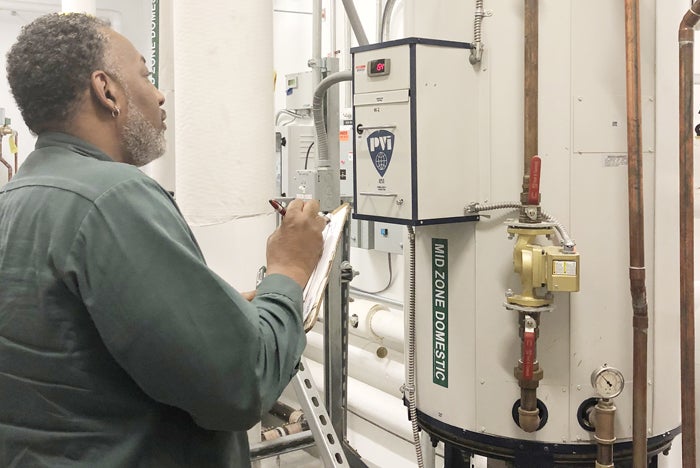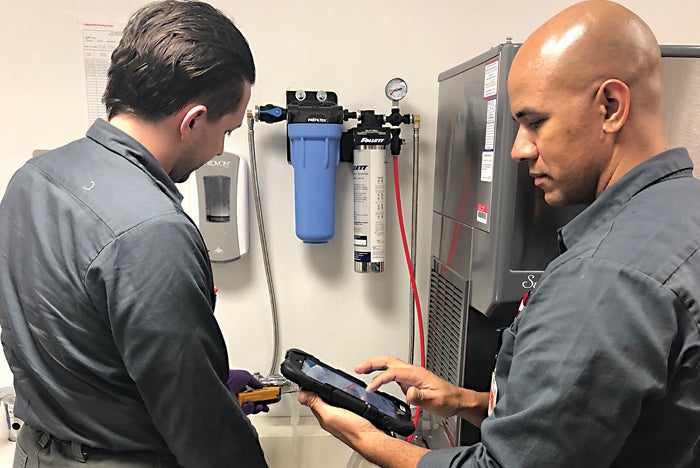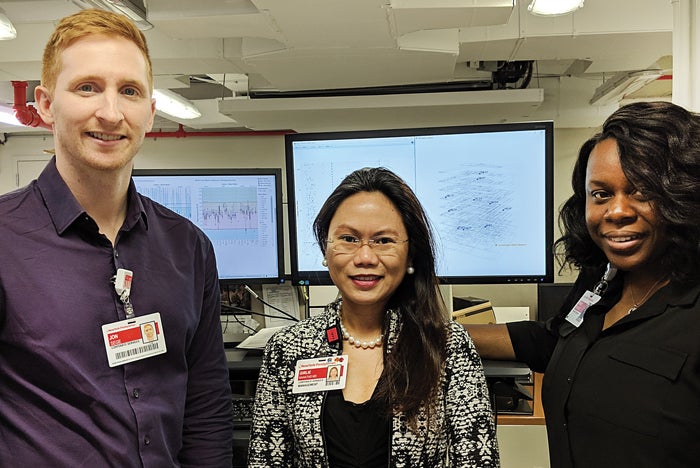Hospital's award-winning program protects water quality

Victor Lawson of facilities operations and engineering monitors water-quality parameters.
Photo courtesy of NewYork-Presbyterian Hospital
The New York City-based NewYork-Presbyterian Hospital (NYPH) system, which serves 2,813 licensed beds across seven hospital campuses spanning 10 million square feet, has worked diligently over the past several years to bolster its defenses against Legionella. In 2005, it established a water safety-management (WSM) program.
Over the past five years, NYPH enhanced the program by creating an interdisciplinary management team and adopting a modernized strategy that employs smart sampling design, algorithms, data standardization, business intelligence, modeling and analytics.
As a result, NYPH has reduced positive Legionella samples detected via routine sampling by 50 percent, decreasing its overall detection rate by 73 percent in 2017; additionally, there haven’t been any confirmed cases of hospital-acquired Legionellosis over the past decade.
Excellence in Health Care Facility Management Award
Winning Entry
- Project: NYPH water-safety program
- Facilities: Seven hospitals across the NYPH system
- Start date: December 2013
- Completion date: Ongoing
- Budget: $56,000
- Actual cost: $56,000
Project Team
- Girlie Manatad, manager of environment of care compliance
- Jon Sege, specialist in environment of care compliance
- Amy Nunziata, vice president of facilities operations
- Larry Borsinger, director of environment of care compliance
- E.Yoko Furuya, medical director of infection prevention and control
- David Calfee, chief hospital epidemiologist
- Sarah Clock, specialist in infection prevention and control
The improved processes have also enabled NYPH to respond quickly to dangers that emerge when managing a massive water system and to generate cost savings by leveraging existing programs and improving data-capture efficiency.
These efforts have caught the attention of the field — most notably the American Society for Health Care Engineering (ASHE), which recently honored NYPH with its 2018 Excellence in Health Care Facility Management Award.
Safety first
Larry Borsinger, NYPH’s director of regulatory compliance, says he’s thrilled that his team was recognized for its accomplishments. “It’s a humbling experience to be recognized by ASHE, and it’s even more rewarding to know that we can share our best practices with others in the field,” he says.
But the focus was always on improving safety and protecting the environment of care.
“We have a very strong commitment to patient and staff safety and the physical environment,” says Borsinger. “Water management has always been a major priority in our hospitals. But in recent years, it’s taken on a larger focus because New York City and the New York State Department of Health have put new Legionella regulations in place. Plus, the Centers for Medicare & Medicaid [Services] and The Joint Commission have implemented more stringent water-management requirements. So, we decided to take our water-safety program to the next level by collecting and correctly reporting more data analytics and aligning these efforts consistently across all our hospitals.”
Girlie Manatad, M.D., MPH, CHSP, manager of environment of care compliance for NYPH, says the program goes beyond compliance.
“We believed that we could do better and design and implement a very proactive, rather than reactive, management program that could establish insight, foresight and control. We also never stopped focusing on how we could continue to improve,” says Manatad. “After buy-in from management, we received the staff dedication, talent and skills to make that vision a reality. That resulted in the current sustainable and adaptable program we have today.”
The goals of the enhanced WSM program are multifold: to prevent disease and injury associated with building water systems; to accelerate response to amend and mitigate risks associated with positive findings; and to operate a program that is streamlined and efficient while maintaining the highest level of safety.
These objectives weren’t achievable without the right people in place. So NYPH created a water-safety committee comprising a multidisciplinary team that includes hospital epidemiologists, clinicians, nurses, infection preventionists, plant facilities technicians, engineers, clinical microbiologists, compliance personnel and administrators across all campuses. The team also collaborates closely with expert water consultants, treatment vendors, water-quality vendors and an independent third-party auditor.
“The seamless collaboration between the clinicians and engineers on the team has allowed for rapid responses to any clinical or environmental water-related issues,” says E. Yoko Furuya, M.D., MS, NYPH’s medical director of infection prevention and control and director of antimicrobial stewardship.
“In our view, it revolutionizes the approach to water management,” Manatad says.
Data-driven strategy
One of the keys to the WSM’s success is its data-management strategy, which involves co-locating water-quality measures in space and time, enabling interoperability with other hospital data sets, and ensuring that sampling locations are well-distributed across each system. Samples for Legionella and other water-quality parameters encompass three dimensions — horizontal, length/width and vertical — throughout each hot-water system. This provides a comprehensive analysis of each system’s performance and possible vulnerabilities.
Co-locating water-quality measures allows the WSM team to model relationships between system metrics (like residual-disinfectant concentrations and temperature) and detectable Legionella. Using predictive data in this fashion empowers the team to make proactive maintenance decisions. They can also combine water-quality data with other data sets, including space inventories, asset-maintenance records and non-protected health information clinical metrics. This way, they can spot Legionella-growth red flags in areas beyond the plumbing system — for instance, in construction areas or building processes.
“Data sets can be developed with consistency and provide transparency on how outcomes are generated. High-level program understanding is easier to convey to staff, contractors and other partners under this holistic and focused approach. And standard-governed data can be consistently interoperated with other systems,” notes Manatad. “These processes permit the team to rapidly identify potential root causes and correlate with other metrics. Any out-of-range measures can be identified and addressed in a timely manner. The program thus ensures reduced time spent on analysis and faster implementation of necessary corrections, monitoring and coordination.”

Darren Courtney (left) and Edwin Martinez of facilities operations and engineering oversee system maintenance.
Photo courtesy of NewYork-Presbyterian Hospital
Improved sampling techniques and more frequent measurements have helped matters, too. At least 13 samples are taken from each potable hot-water system every 90 days, adding up to more than 1,500 Legionella samples taken annually. Hot water-return temperatures are also measured monthly and compared with known ranges for Legionella growth, and residual disinfectant distributions are measured in each system and compared with target ranges monthly.
“Proper water management requires a lot more than sticking meters in the water and recording numbers,” Borsinger adds. “Ten years ago, you simply hired a third party, generated a report and stuck it in a binder. Today, however, you have to create an interdisciplinary team that works selectively with key vendors. You have to look closely at your data to see how things are trending. That’s why I encouraged the creation of a definable, sustainable and predictable program throughout our campuses — one that’s numbers-driven and that we can react quickly to and manage much closer.”
Proactive prevention
The proof of NYPH’s WSM program, of course, are in those numbers. Consider that compliance with internal audit standards has improved by 21 percent year to year between the second quarter of 2017 and 2018. What’s more, the Legionella detection rate has fallen from 13 percent in 2005 to only 3.5 percent in 2017.
“The program enhancement has been successful and has led to reliability of the process. Consequently, a condition can be addressed in a timely manner and risk-mitigation plans can be executed smoothly,” says Manatad. “The data show that we have a much stronger handle on the findings and that our approach delivers positive results and improvements.”
Still, Furuya insists that this is a work in progress. “We continue to re-evaluate and evolve how we display and analyze these data to allow for a more thorough assessment of water safety and easier, more intuitive interpretation of the data. This has facilitated further discussion and planning,” says Furuya.
Manatad agrees, noting that there’s always room for improvements and fine-tuning.
“The next enhancement is to account for external factors and how they potentially influence our predictability. For instance, if we initiate a construction project in one of our facilities, which is considered a nonstandard event, we are trying to figure out how we can predict and test any enhanced exposures,” explains Manatad.
What’s important, Manatad adds, “is to get as far away as possible from the reactive method — the ‘a problem occurs, let’s deal with it’ approach — and move as close as possible to the proactive mode wherein control is achieved by diligent operation, maintenance, testing and predictability models.”
Borsinger is confident that testing protocols will continue to progress and that his team has matters firmly in control.
Outcomes and expectations
Health facility professionals at NYPH offer a number of lessons learned during their journey [see sidebar, Page 26]. The first step? Assemble the right multidisciplinary group composed of clinical and engineering pros.
“Ownership, accountability and collaboration make the program a success, so put the best people on the team and focus on the process. Don’t be shy about taking the steps for continued process improvement,” says Manatad, who adds that the multidisciplinary nature of a carefully curated team will pay off. “For example, besides having a master’s degree in public health, I also am an MD. That has helped me tremendously in bridging the operational side with the medical side of our program. As such, it was easier to take a holistic approach to designing and implementing the program in a hospital setting.”
It’s also crucial to “have a rigorous monitoring plan and the ability to present and analyze the data effectively to make the right strategic decisions,” suggests Furuya.
Furthermore, when testing and monitoring are performed, facility professionals should review and evaluate how the findings will impact the program. “Remember that quality is much more guaranteed in a controlled than in a reactive environment that’s focused chiefly on compliance,” adds Manatad.
Lastly, health facility professionals should aim to communicate and coordinate all information with stakeholders in a timely manner. “In the end, we are dealing with patient and staff safety, and the organization’s reputation is subsequently based on that,” Manatad says. “Always keep this bigger picture in mind.”
Erik J. Martin is a freelance writer based in Oak Lawn, Ill.





